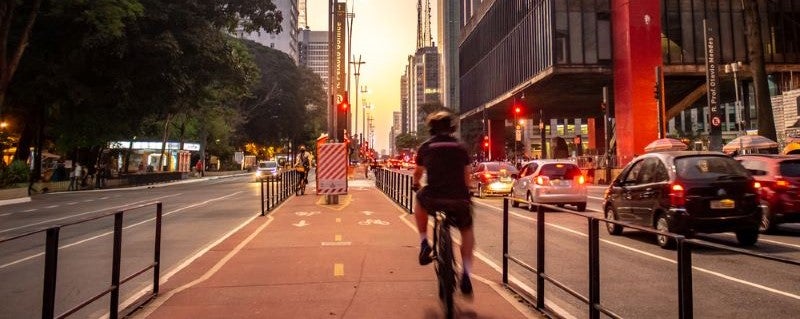 A photo of Paulista Avenue at twilight in Sao Paulo, Brazil
A photo of Paulista Avenue at twilight in Sao Paulo, Brazil
São Paulo is the economic powerhouse of Brazil. With a metropolitan population of over 22 million people, it is also the largest city in the Southern hemisphere. But for low-income populations or people with a disability or other minorities with a socio-economic disadvantage, getting around the sprawling metropolis can be a challenge. Meanwhile, transport comprises 80% of emissions in São Paulo, a serious detriment to air quality.
To address these issues of accessibility, emissions, and overall faltering demand for public transport, the World Bank has been working with local partners on the Smart Mobility Program, which kicked off in 2019 with financing from the UK Prosperity Program. “Smart” is the keyword here and has been at the heart of our vision for the future of transport in São Paulo.
But what exactly is smart mobility—or a smart city, for that matter?
While there is no universal definition, our experience in Brazil and other countries has shown that the smart city concept follows a clear logic. More than anything, it is a city that leaves no one behind and considers the needs of those who are in situations of vulnerability. To make this happen and foster inclusion, a smart city then uses the necessary technological tools to improve city planning, management, and operation.
With this in mind, the Smart City team, together with the Municipality of São Paulo, considered people who faced barriers to access opportunities across the city. We reached out to citizens through surveys and focus groups to get a better picture of their mobility needs and understand the challenges they were facing. Our activities included producing training manuals and organizing discussions on policies that would promote sustainable modes of transport (such as cycling and walking) to be included in urban logistics.
After hearing from citizens, the Smart City team prioritized key services including the bus management and the traffic lights in the city. There are now roadmaps that will help the implementation of universal accessibility transformation for safe school routes or complete streets prioritizing pedestrians and with a focus on people with disabilities, and a detailed plan to develop a program for improving bus management efficiency, innovating with the automatization of critical processes for establishing real-time planning with big data in partnership with local authorities.
We also collaborated on improving the regulatory and policy framework to provide better urban mobility services for women and people in socio-economically vulnerable situations.
The work's entire foundation was established by structuring policies aimed at creating a sustainable city, which encompasses qualities such as being humane, efficient, green, and safe, all overseen by intelligent governance from the Municipal Government and public entities. The conceptual model is consolidated in this main report.
In many activities, it was important to learn from best practices in other global cities, such as Singapore, Berlin, Vienna, Barcelona, Paris, London, Istanbul, Santiago de Chile, New York, or Bogotá. These are cities that have already put in place many of the principles of a smart city, such as , inclusive mobility, pedestrian and cycling infrastructure, traffic light management, or integrated services in the public Mobility as a Service (MaaS).
The five-year partnerships between the World Bank and the municipality has turned São Paulo into a smarter city – with plans to implement efficient monitoring systems for buses, putting gender, disability, and minority inclusion needs at the core of public transport companies and expanding school routes for all , among other topics. The Municipality is keen to green their bus fleet and improve their operations. The idea of mobility as a service is more ingrained and policies inclusive to women, Afro-descendants, and people with disabilities are being put in place, following the recommendations made to reduce the mobility barriers, such as high tariffs or sexual harassment for women which disproportionally affects more those living in the periphery (mostly afro-descendants – as mentioned in the report) There’s a lot of work ahead and we at the World Bank are committed to helping the Municipality transform São Paulo into an even smarter city – especially with the implementation of the BRT Aricanduva (P169140) and the electrification of buses project (P500501).
For more information about Smart Cities, check out these blogs.


Join the Conversation